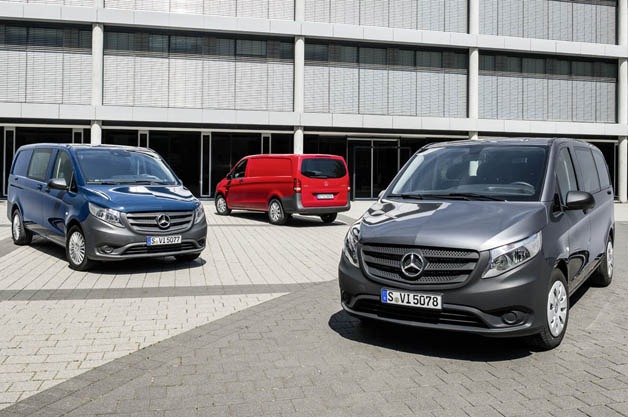
Mercedes-Benz may
be known for its luxury cars on this side of the Atlantic, but it's equally
known around the world for making robust workhorses as well: trucks, buses and
vans. It has started to turn Americans on to that idea with the successful
transplant of the Sprinter van
to North America, but it still has a whole range of commercial vehicles it
doesn't offer here. It recently rolled out the Renault-builtCitan to replace its Vaneo,
replaced its Viano with
the new V-Class,
and it has now introduced a newVito van as well.
More utilitarian than the V-Class, the Vito is a smaller alternative to the Sprinter and hits showrooms in other global markets in a wide array of configurations. For starters, it will be available in numerous lengths as a panel van, a passenger van or as a crew cab, a configuration that combines a four-door passenger compartment with a cargo bay in the back. It's also intriguingly available in front-, rear- or all-wheel drive, motivated by a pair of four-cylinder turbodiesels displacing 1.6 liters or 2.1 liters with power ranging from 136 horsepower up to 190. Regardless of engine selection, buyers can choose from either a six-speed manual or seven-speed automatic.
In addition to a wider range of powertrain and bodystyle choices, Mercedes has also redesigned the new Vito to be safer and more comfortable than the model it replaces. It has a more aerodynamic shape for a lower coefficient of drag that pairs with the new engines to help reduce fuel consumption. That's particularly important to the vehicle's competitiveness among fleet buyers, because improved fuel economy leads to reduced running costs. Further, the new Vito can be kept on the road for 25,000 miles over two years in between service intervals.
Despite the suspension that's been redesigned for a more compliant ride, the new Vito doesn't skimp on the utility. In fact, Mercedes claims it's got the highest payload capacity in its class at over 3,000 pounds and a Gross Vehicle Weight Rating of over three tons, depending on spec
More utilitarian than the V-Class, the Vito is a smaller alternative to the Sprinter and hits showrooms in other global markets in a wide array of configurations. For starters, it will be available in numerous lengths as a panel van, a passenger van or as a crew cab, a configuration that combines a four-door passenger compartment with a cargo bay in the back. It's also intriguingly available in front-, rear- or all-wheel drive, motivated by a pair of four-cylinder turbodiesels displacing 1.6 liters or 2.1 liters with power ranging from 136 horsepower up to 190. Regardless of engine selection, buyers can choose from either a six-speed manual or seven-speed automatic.
In addition to a wider range of powertrain and bodystyle choices, Mercedes has also redesigned the new Vito to be safer and more comfortable than the model it replaces. It has a more aerodynamic shape for a lower coefficient of drag that pairs with the new engines to help reduce fuel consumption. That's particularly important to the vehicle's competitiveness among fleet buyers, because improved fuel economy leads to reduced running costs. Further, the new Vito can be kept on the road for 25,000 miles over two years in between service intervals.
Despite the suspension that's been redesigned for a more compliant ride, the new Vito doesn't skimp on the utility. In fact, Mercedes claims it's got the highest payload capacity in its class at over 3,000 pounds and a Gross Vehicle Weight Rating of over three tons, depending on spec
source: Autoblog
by Noah Joseph
http://www.boscheuropean.com
No comments:
Post a Comment